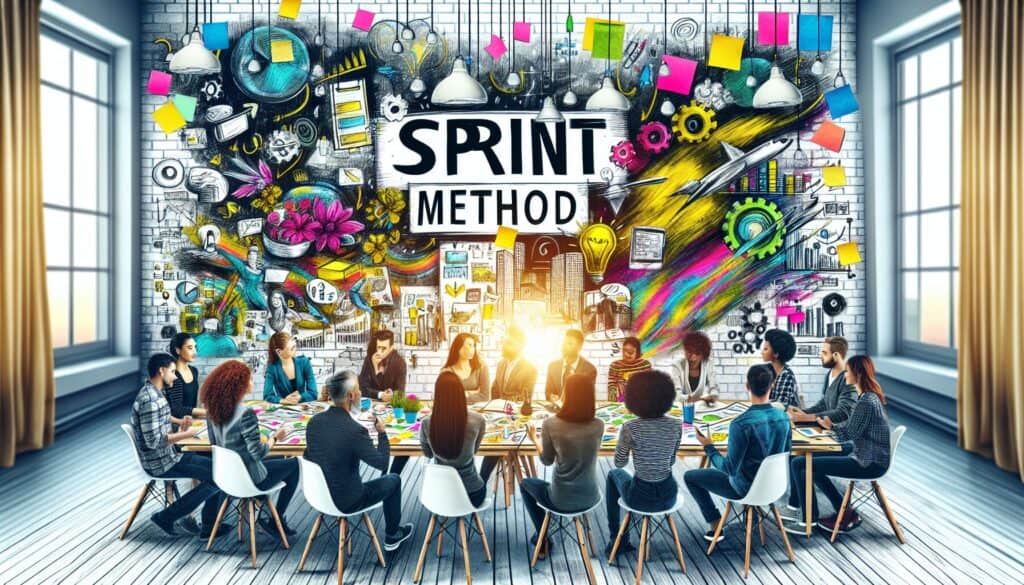To rapidly solve big challenges, create new products, or improve existing ones through intensive, time-boxed (typically 5-day) collaboration, prototyping, and user testing.
- المنهجيات: العملاء والتسويق, الأفكار, حل المشكلات, تصميم المنتج, الجودة
طريقة سبرينت (سبرينت التصميم)

طريقة سبرينت (سبرينت التصميم)
- المنهجية الرشيقة, التعاون بين الوظائف, سباق التصميم, التفكير التصميمي, ابتكار, النماذج الأولية, النماذج الأولية السريعة, اختبار المستخدم, تصميم يركز على المستخدم
الهدف:
كيفية استخدامه:
- A structured five-phase process: Understand (map out the problem, pick a focus), Sketch (generate broad solutions), Decide (select the best solutions), Prototype (build a realistic prototype), and Test (get feedback from real users).
الايجابيات
- Fast-paced results, user-centric, reduces risk of building the wrong product, fosters team alignment and collaboration, tangible output (prototype and test results).
سلبيات
- Requires significant dedicated time from a cross-functional team, can be intense and exhausting, success depends heavily on facilitator skills and team participation, might not be suitable for all types of problems (e.g., very complex, long-term research).
الفئات:
- العملاء والتسويق, الأفكار, حل المشكلات, تصميم المنتج, إدارة المشاريع
الأفضل لـ
- Validating product ideas, designing new features, solving complex تحديات التصميم, and fostering innovation in a short timeframe with clear, actionable user feedback.
The Sprint Method, particularly in design contexts, is widely applicable in technology and product development sectors, including software engineering, consumer electronics, and health tech, where rapid prototyping and iterative testing can significantly influence market readiness. Organizations engage cross-functional teams, including designers, engineers, product managers, and stakeholders, to initiate sprints, ensuring diverse perspectives contribute to identifying and addressing user needs. This methodology is especially effective during the ideation and early development phases of project lifecycles, allowing teams to validate or pivot ideas before heavy investments are made. For instance, a software company might use a design sprint to refine a mobile app feature by rapidly constructing a prototype to test with actual users, which leads to actionable feedback that informs further development. By condensing a potentially lengthy development cycle into a focused week, teams can quickly assess the viability of their concepts, which can lead to reduced time-to-market. The collaborative nature of sprints not only aligns team members toward common goals but also cultivates a shared understanding of customer needs and expectations, thereby enhancing the likelihood of product-market fit. Successful application of this methodology has been documented in top-tier organizations such as Google and ليجو, illustrating its effectiveness in diverse industries and enhancing innovation capacity.
الخطوات الرئيسية لهذه المنهجية
- Map out the problem and identify a specific focus.
- Generate a variety of potential solutions through sketching.
- Select the most promising solutions for further development.
- Create a realistic prototype representing the chosen solutions.
- Test the prototype with real users to gather feedback.
نصائح للمحترفين
- Involve cross-functional team members early to ensure diverse perspectives are incorporated and align on objectives swiftly.
- Prioritize user feedback by engaging with a target audience representative in the testing phase to obtain actionable insights.
- Document every phase comprehensively to facilitate reflection and iterative improvements for future sprints and projects.
لقراءة عدة منهجيات ومقارنتها, نوصي باستخدام
> مستودع المنهجيات الشامل <
مع أكثر من 400 منهجية أخرى.
نرحب بتعليقاتكم على هذه المنهجية أو المعلومات الإضافية على قسم التعليقات أدناه ↓، وكذلك أي أفكار أو روابط متعلقة بالهندسة.
السياق التاريخي
1950
1950
1950
1960
1960
1960
1960
1950
1950
1950
1958
1960
1960
1960
1960
(إذا كان التاريخ غير معروف أو غير ذي صلة، على سبيل المثال "ميكانيكا الموائع"، يتم تقديم تقدير تقريبي لظهوره الملحوظ)















منشورات ذات صلة
استبيانات الانزعاج العضلي الهيكلي
الاختبار متعدد المتغيرات (MVT)
تحليل الانحدار المتعدد
أنظمة التقاط الحركة
طريقة MoSCoW
اختبار متوسط المزاج